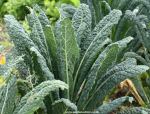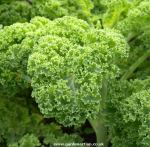Categories
Calendars
Guides
Reviews
Archive
Gallery
Articles
Ask Our Gardening Expert
Not only is Kale a tasty vegetable with a long
cropping season but it is a very attractive vegetable as well.
Many gardeners grow them in their borders purely for their
ornamental value, especially over winter. Kale is resistant to most
pests and diseases and grows in almost any site and position.
Site and Soil Sowing Seed Sow the kale seeds about 1.5cm (�in) deep in rows which are 22cm
(9in) apart. germination will take about 10 days. When the plant is
about 22cm / 9in high and four leaves have developed (about 6 weeks
after sowing) transplant them to their final positions. They should be
planted slightly deeper than they grew in the seed bed. Spacings are
45cm / 18in apart with rows the same distance apart. Rape kale should be sown slightly late in the season, May to June is
a good time. Sow them directly in their final position because they do
not like to be transplanted. Care for Kale
Almost no care is required because these are
one of the strongest and most disease resistant of all vegetables.
Remove yellowing leaves which will appear round the base of plant. Keep
the weeds under control with regular hoeing. Dwarf varieties of kale (see curly / crinkly kale to the right)
will withstand winter winds especially well. Harvesting Kale Harvest the young leaves only which will be at the top of the plant.
This will stimulate the plant to produce more young tender leaves. Recommended Varieties Cavolo Nero Dwarf Green Curled
Types of Kale When you look in the seed catalogues for Kale you will see four main types.
Curly-leaved kale is probably the most commonly grown and has leaves which look like
parsley. A hardier type is the plain-leaved Kale which will survive even the
harshest of weather. Rape Kale and the relative new comers Leaf and Spear. They are all treated the same
although they crop at slightly different times of the year.
When you look in the seed catalogues for Kale you will see four main types.
Curly-leaved kale is probably the most commonly grown and has leaves which look like
parsley. A hardier type is the plain-leaved Kale which will survive even the
harshest of weather. Rape Kale and the relative new comers Leaf and Spear. They are all treated the same
although they crop at slightly different times of the year.
There is an ideal soil and site for Kale but rest assured, it will grow
in almost all conditions, even part shade and sandy soils will produce a
reasonable crop. For the ultimate crop, grow in a soil that was enriched
with compost or manure the previous season. Full sun is best but they
will grow well in part shade.
With the exception of rape kale, sow the seeds in a seed bed around
April to May time. The timing is not crucial because kale will germinate
in temperatures as low as 5�C / 42�F and as high as 35�C / 95�F. That's
an enormous range for any vegetable.
Harvest kale only when you need it because it does not keep
well even in the fridge. They provide a crop between late September to
early May, although rape kale is at its best in spring.
With so many types to choose from, the selection of particular varieties
is one of personal choice. We recommend two below which we have enjoyed.
We grew this one because it is often asked for in recipes. The leaves
are highly crinkled, deep green and the plants look spectacular.
This is a dwarf variety that grows strongly with little fear of damage
from strong winds. It looks like parsley with deeply crinkled leaves.
the cropping season is autumn to mid spring. Click here
for our recommended online supplier of this variety.
